1lumen selects and reviews products personally. We may earn affiliate commissions through our links, which help support our testing.
Olight Baton 3 Pro Max review
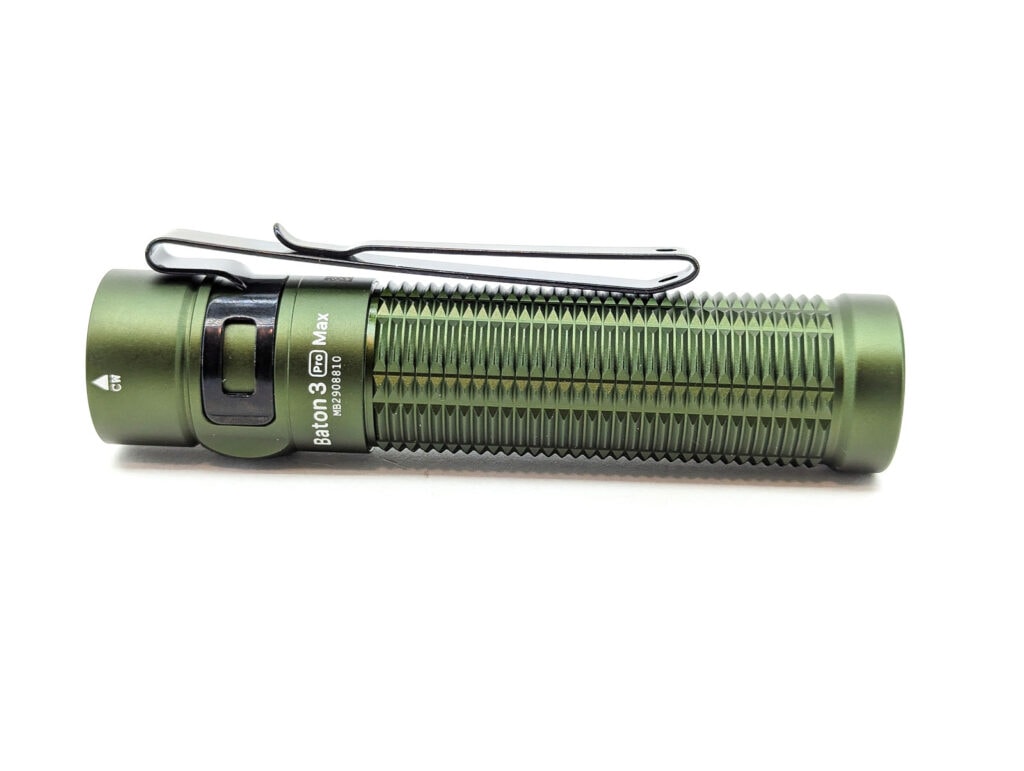
Olight Baton 3 Pro Max specifications
| Brand & Model | Olight Baton 3 Pro Max |
|---|---|
| Flashlight category | EDC |
| LED | (unknown) |
| Max. output | 2500 lumens |
| Max. beam distance | 145 meters |
| Max. beam intensity | 5,295 cd |
| Battery config. | 1x 21700 |
| Onboard charging | Proprietary |
| Modes | 5 |
| Blinkies | Strobe |
| Waterproof | IPX8 |
| Review publication date | January 2023 |
Introduction:
Olight has a pretty broad selection of lights. They make some great keychain lights such as the i3E EOS and the i1R 2 Pro. Olight also has EDC lights like the Baton series. But that’s not all… gun lights, tactical lights, high-power lights, general lamps/lanterns, and now branching out into things like knives and pens. For the most part, if it needs to be lit up, Olight has you covered. One of the things I love most about Olight is its attention to detail. Quality is generally fantastic, and anodizing and machining are great… they know how to make a solid product.
A few months back, I got the chance to review the Olight Baton 3 Pro. I found it to be a really well-rounded 18650-based EDC flashlight. As I’ve come to expect from Olight, the fit & finish, regulation, modes, and UI were all really good. Now Olight is back with a new model – the Olight Baton 3 Pro Max. As the name implies, this is an upsized version of the Baton 3 Pro. Rather than the 18650 battery, the Max takes a 21700 battery. The changes go deeper than that, though, so let’s dive in!
Package quality.
Some Olights come in fantastic heavy-duty two-part nested containers with splashy images of the light inside and meticulously arranged contents. Other lights, like some of the more EDC models, come in nice, but not overdone, packaging that feel like less of a presentation case and more of an actual carton to be recycled. The Baton 3 Pro Max came in one of the latter packages. It’s nice, clean, and gets the point across without investing too much in the box. Sliding out the inner, formed plastic tray reveals:
- Olight Baton 3 Pro Max
- Battery (ORB-217C50)
- Pouch
- L-shape stand
- MCC3 charging cable
- Manual
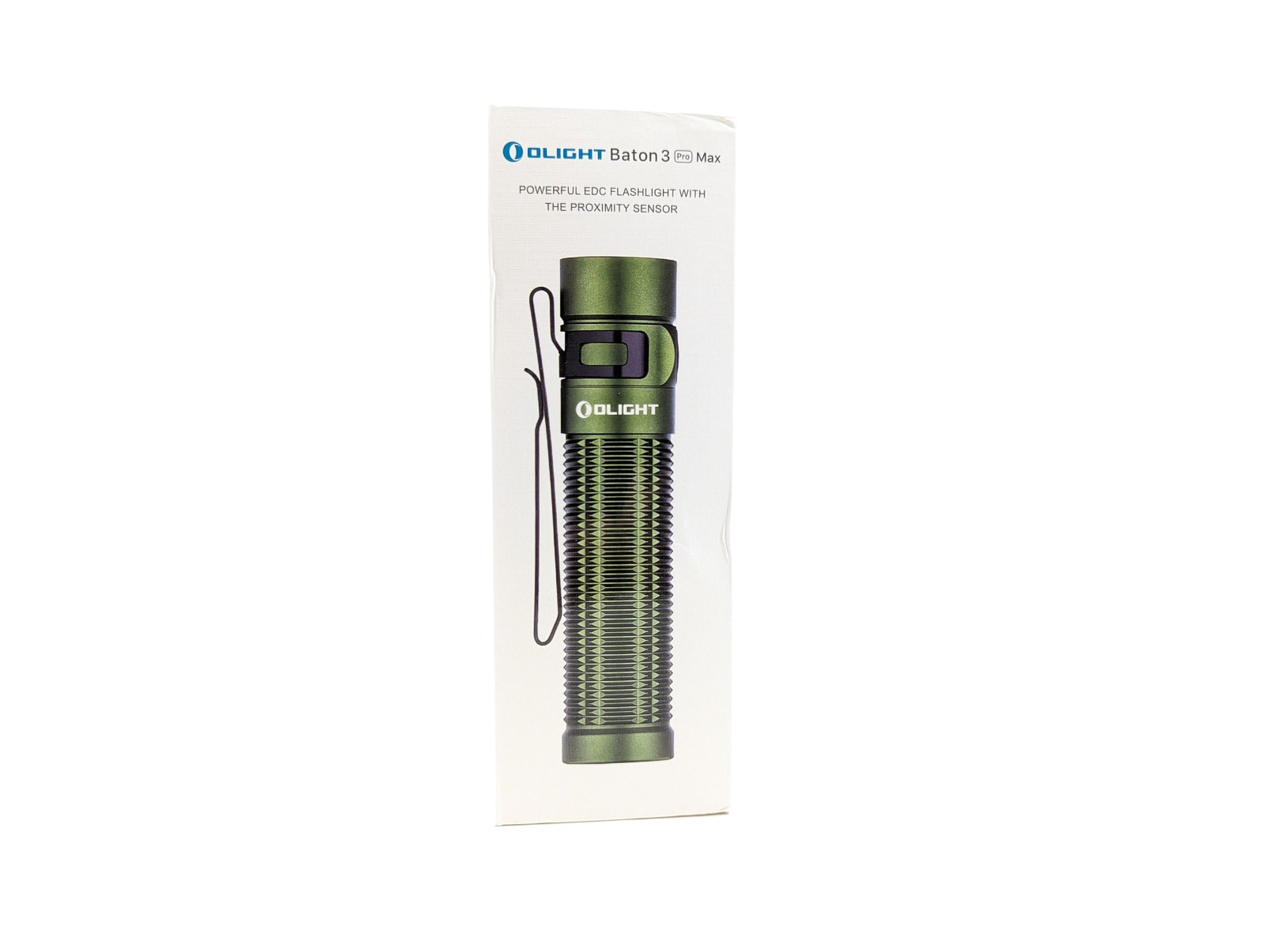
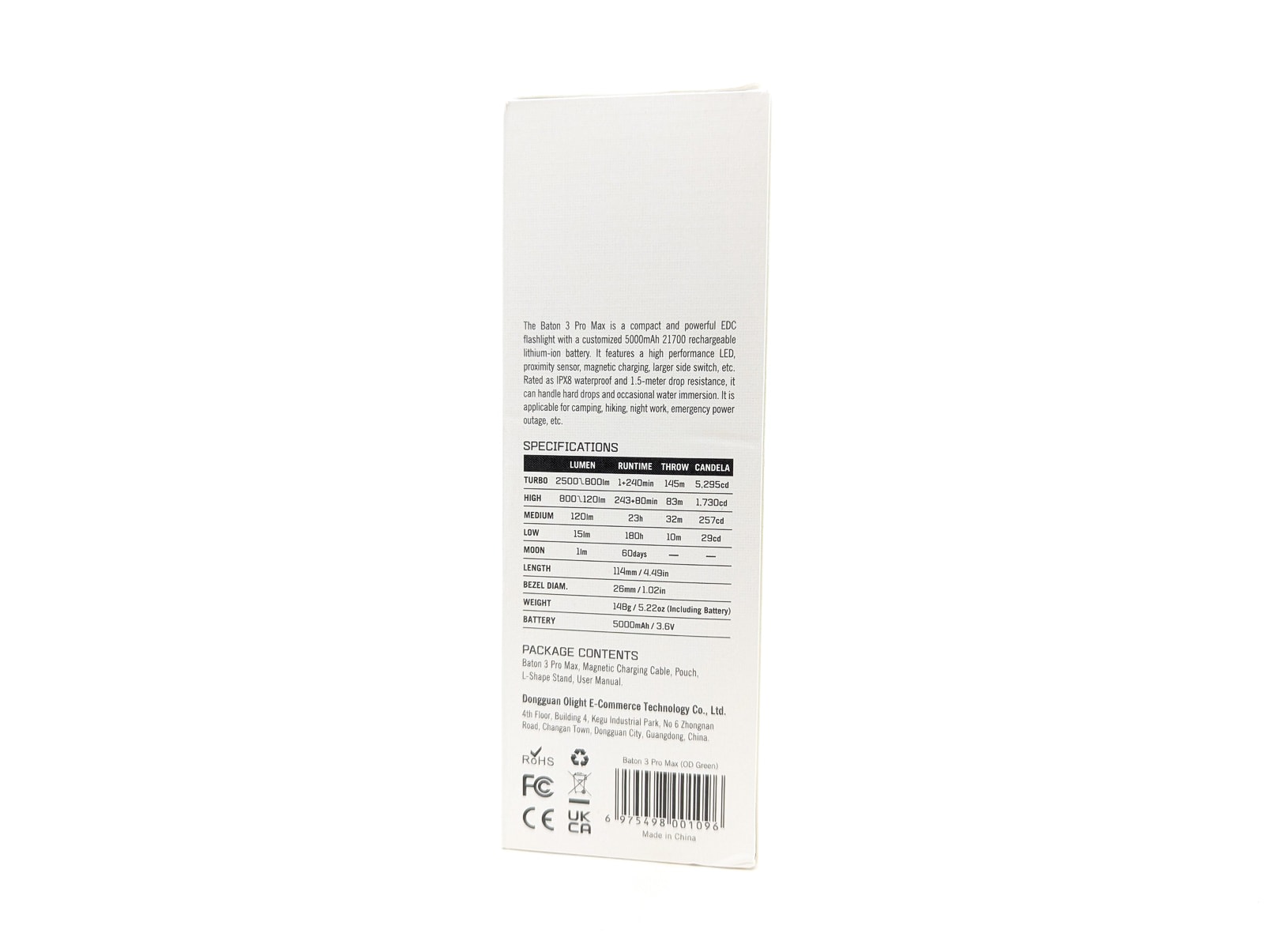
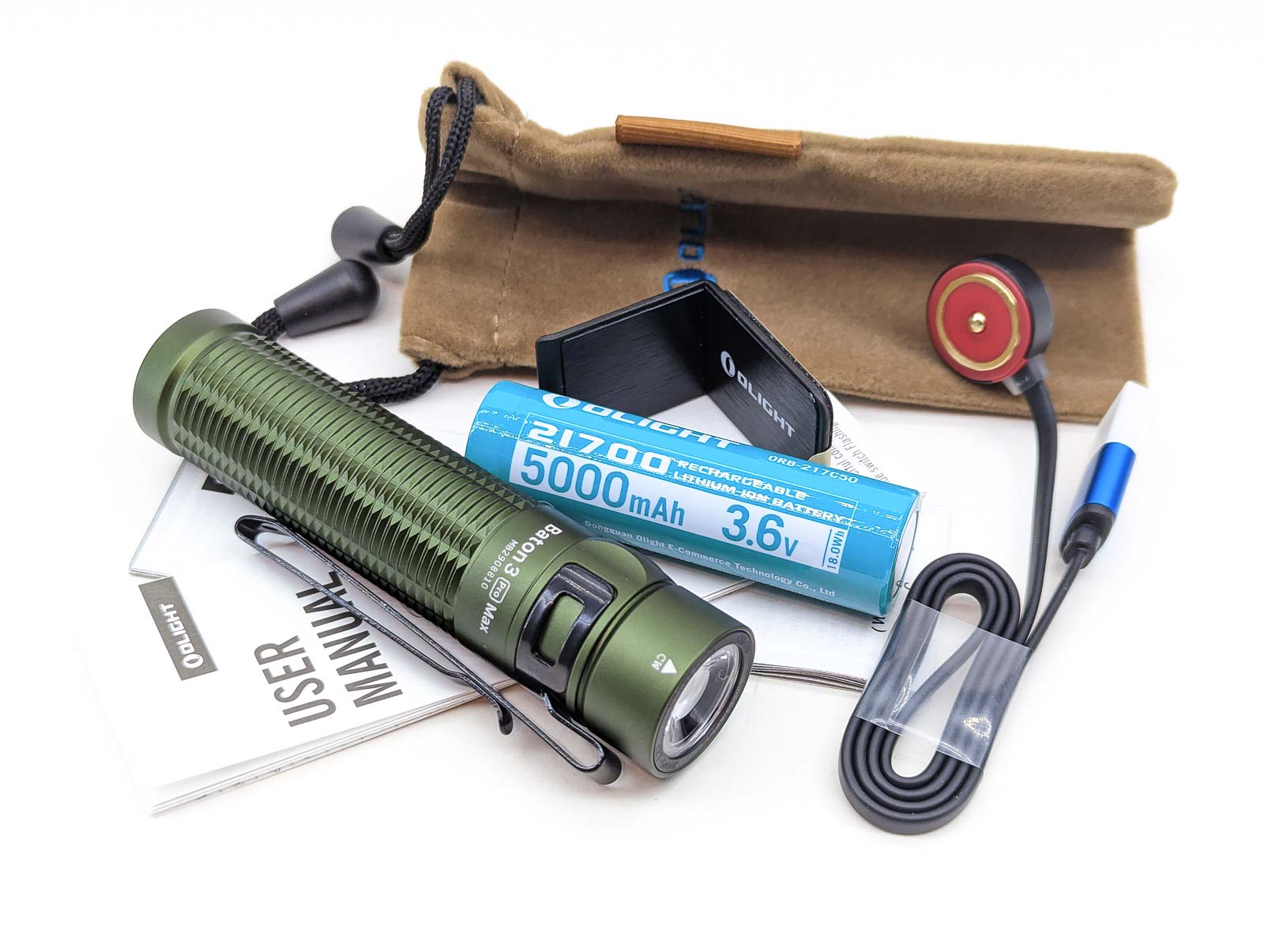
Flashlight in use
To put this simply, the Olight Baton 3 Pro Max looks like my Baton 3 Pro would if it had a few too many Christmas sweets over the holidays. Olight has maintained a very clear design language with the Baton series, making slight tweaks here and there with the new releases while still being very recognizable as an Olight Baton. From its smaller 18650 sibling, the 21700-based Baton is about 12 mm longer and 3 mm wider. That means it won’t disappear into your pocket quite as well, but as far as 21700 lights go, it’s still pretty svelte. This Max model brings 67% more lumens and 56% more battery capacity. Not bad for the small bump in size!
The Olight Baton 3 Pro Max uses a single e-switch on the side of its head. Olight switched it up a bit on the Max and went with a larger (wider) button for easier activation. They also made it less pronounced, though, to help prevent accidental activations.
The clip, which comes pre-installed, is a two-way clip so you could fit it on a ball cap if you needed to (it seems a bit large for that, but it should work in a pinch). And when carried head-up, the clip is “deep carry”, allowing the light to nearly disappear into your pocket.
Olight included a travel / storage pouch for the Baton in the packaging. The pouch has a velvety feel to it and makes a nice addition. There was another accessory included that I first saw with the Baton 3 Pro: a steel L-shaped stand. It has an adhesive pad on one side for attaching to a convenient surface (headboard, dashboard, desk, etc). With the tail of the Baton being magnetic, it attaches firmly to the stand. And since the tail is very flat, it can tail-stand with ease, even when it’s not magnetically attached to a surface.
Another usability feature that Olight included is the proximity sensor. When the Baton senses light bouncing back at it while in Turbo or High mode, it will drop the output down to a Medium mode (120 lumens). This isn’t something new for Olight, several previous models had a proximity sensor. But on those, there was a visible cutout in the optic to make room for the sensor. There is no set-aside area of the optic in the Baton 3 Pro Max. There appears to be a thin ring around the TIR optic – perhaps that entire ring is part of the sensor. The Baton 3 Pro has a very similar sensor, but the Max has a new trick. Not only can you temporarily turn off the proximity sensor as before (double click when it kicks in), you can now disable the sensor (hold the button for 2 seconds while the light is plugged in). Thank you, Olight – that makes runtime testing a whole lot easier.
The Olight Baton 3 Pro Max is a nice EDC flashlight. It’s appropriate for all sorts of uses like hiking, dog walking, in the garage, etc. And with its moonlight mode, it’s not too bad for low-light late-night tasks like book reading or navigating to the bathroom, especially if you opt for the NW or WW versions.

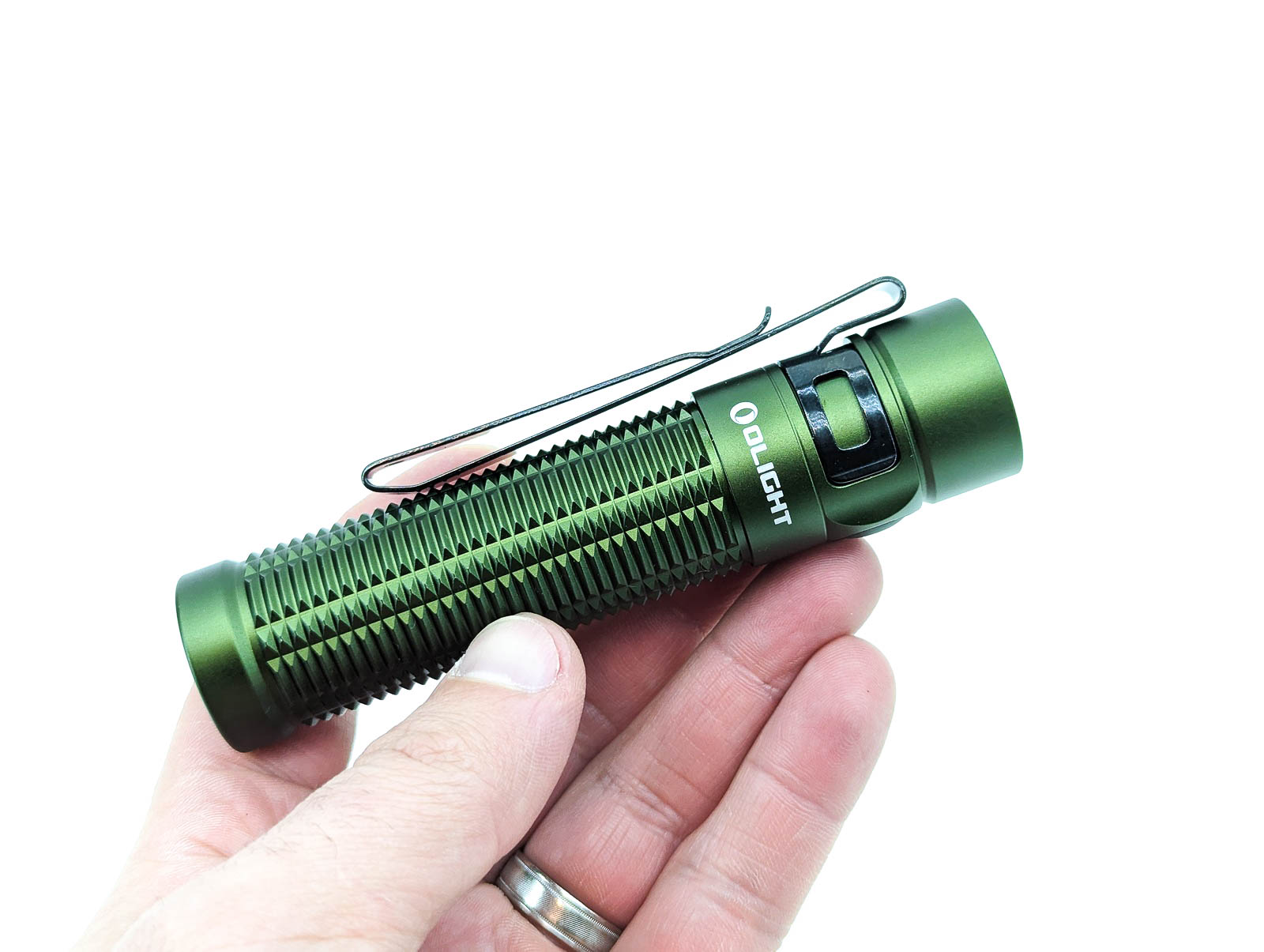
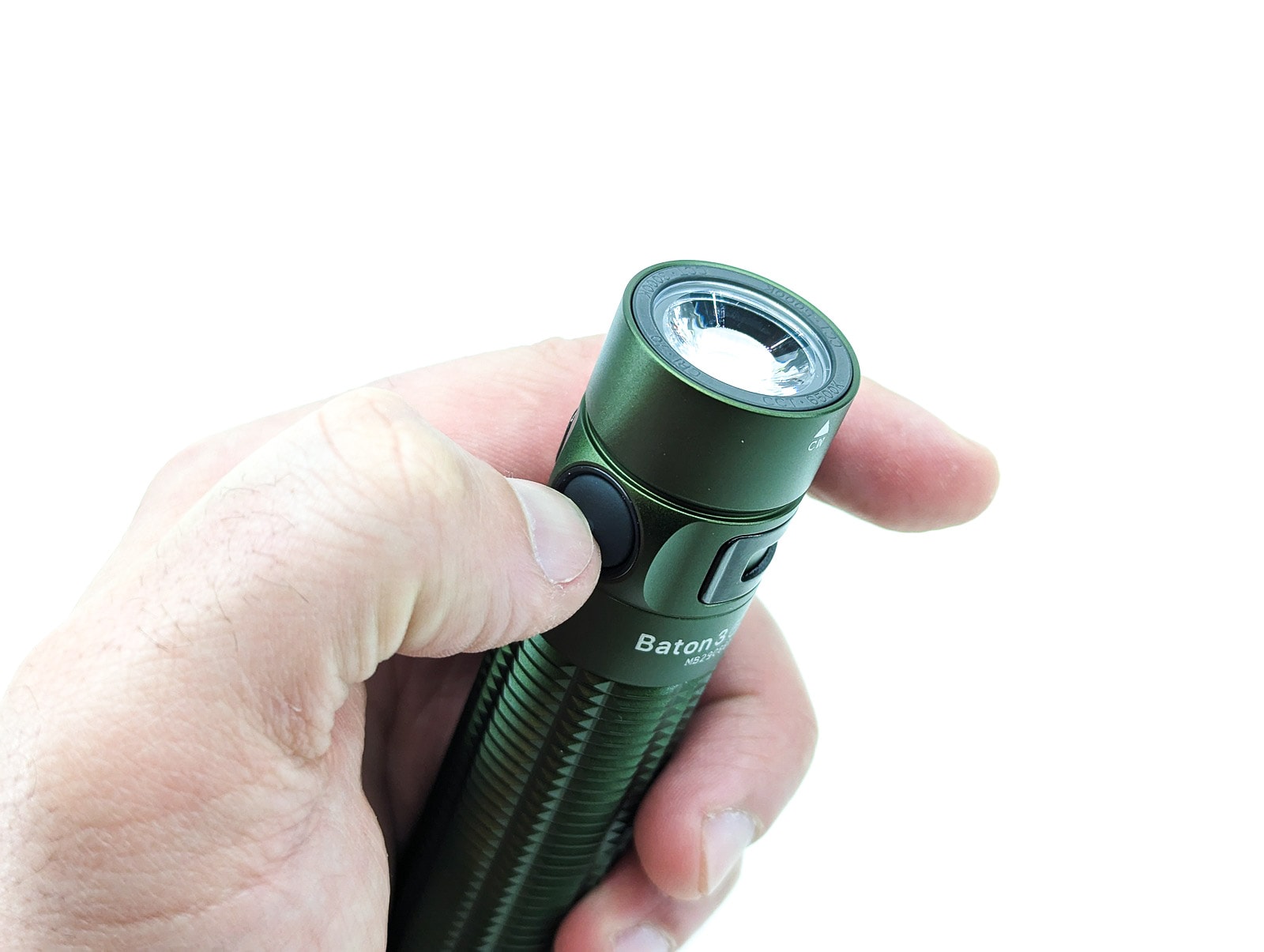
Build Quality, and Warranty
Like most flashlights, the Baton 3 Pro Max is made from aluminum. Well, at least mine is (more on that later). Olight then covered it in a great anodized coating. Mine came in this nice OD Green colorway. The Max is also available in black-anodized aluminum. But that’s not all – the Baton 3 Pro Max is also available with a Desert Tan Magnesium Alloy body, a first for Olight. It’s not the first time a light has been made from a magnesium alloy – a quick search shows that the Fenix HM65R and SureFire Maximus headlamps both used magnesium. This abundant mineral is lighter than aluminum and is supposed to be pretty good at heat dissipation. There is some potential concern about corrosion (and perhaps flammability), but I don’t know just how much of a concern that is – only time will tell.
The Baton 3 Pro Max uses a knurling pattern that is similar to the Baton 3 and Baton 3 Pro. I’m not a machining expert, so I don’t know exactly what to call it, but it’s a series of large ridges that provide plenty of grip. As I would expect from Olight, everything is nicely cut and chamfered. The clip uses a wider attachment point than usual, which should ideally keep it well attached to the body.
Olight’s warranty:
At Olight, we always care about your experience as a customer and want to ensure you have no concerns regarding after-sales service. On September 16th, 2023, we sincerely make the following important promise:
If you purchased an Olight® product from Australia, China, France, Germany or the USA after January 1st, 2023, the local service centers in these countries will honor your LIFETIME WARRANTY for your purchase. If your Olight® product (including its structure, built-in battery, LED, or lens) ever experiences any issues, we promise to take care of it. If we are unable to repair your product, we will promptly replace it with a product in perfect working condition, which will be of equal or better physical condition. If your purchase is a limited or discontinued edition of Olight® product, we will repair or replace it with another Olight® product of the same or higher value.
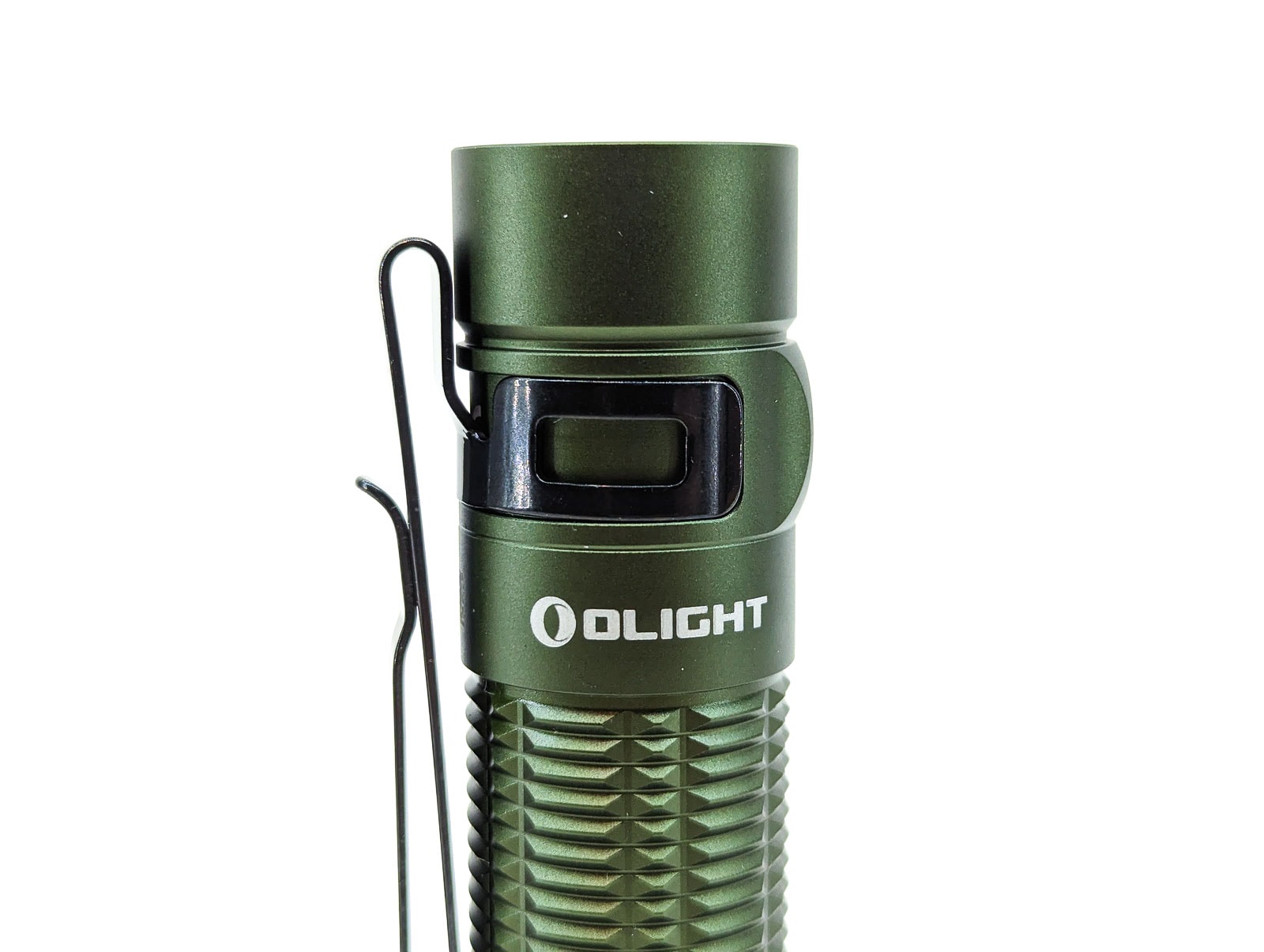
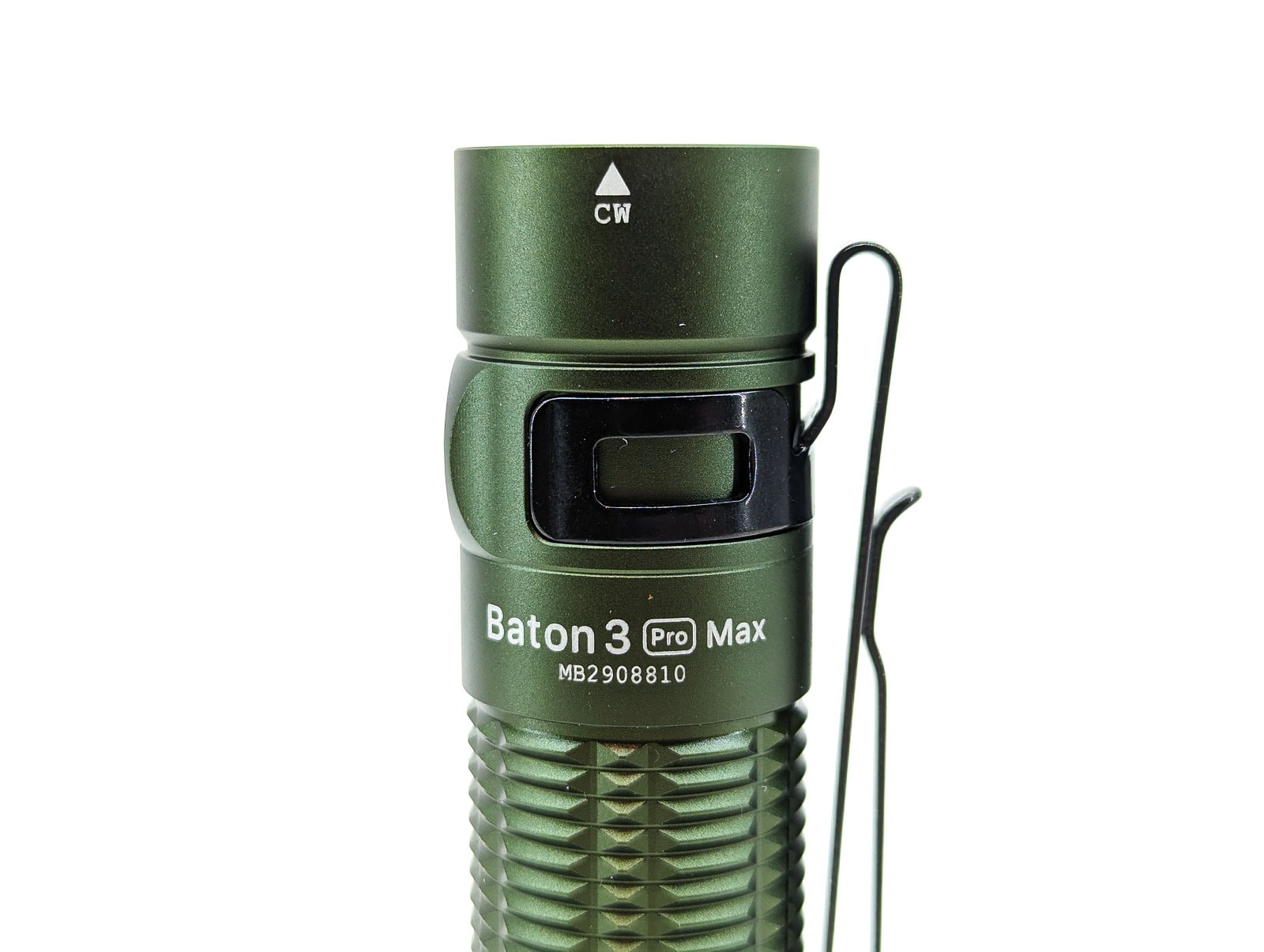
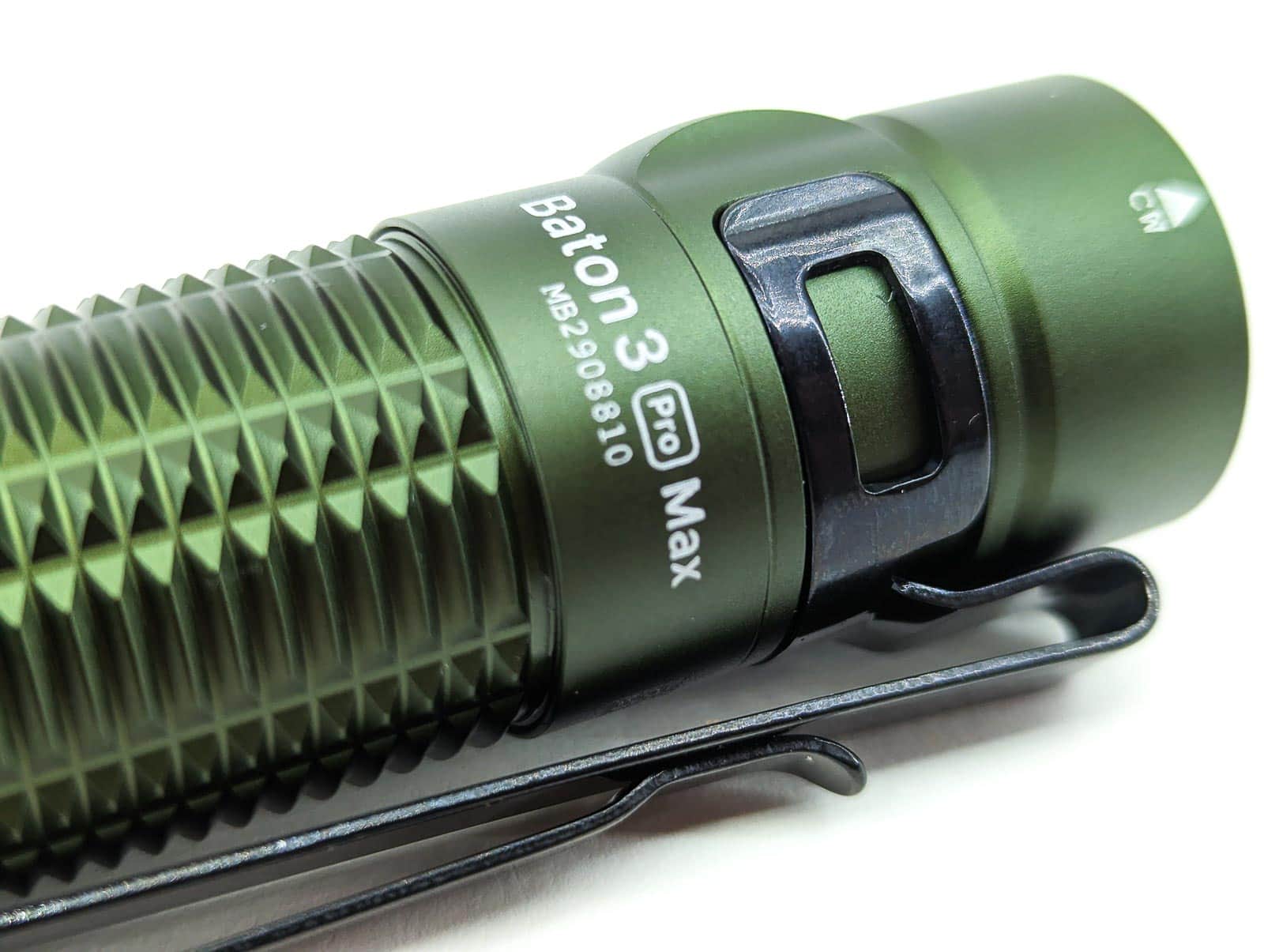
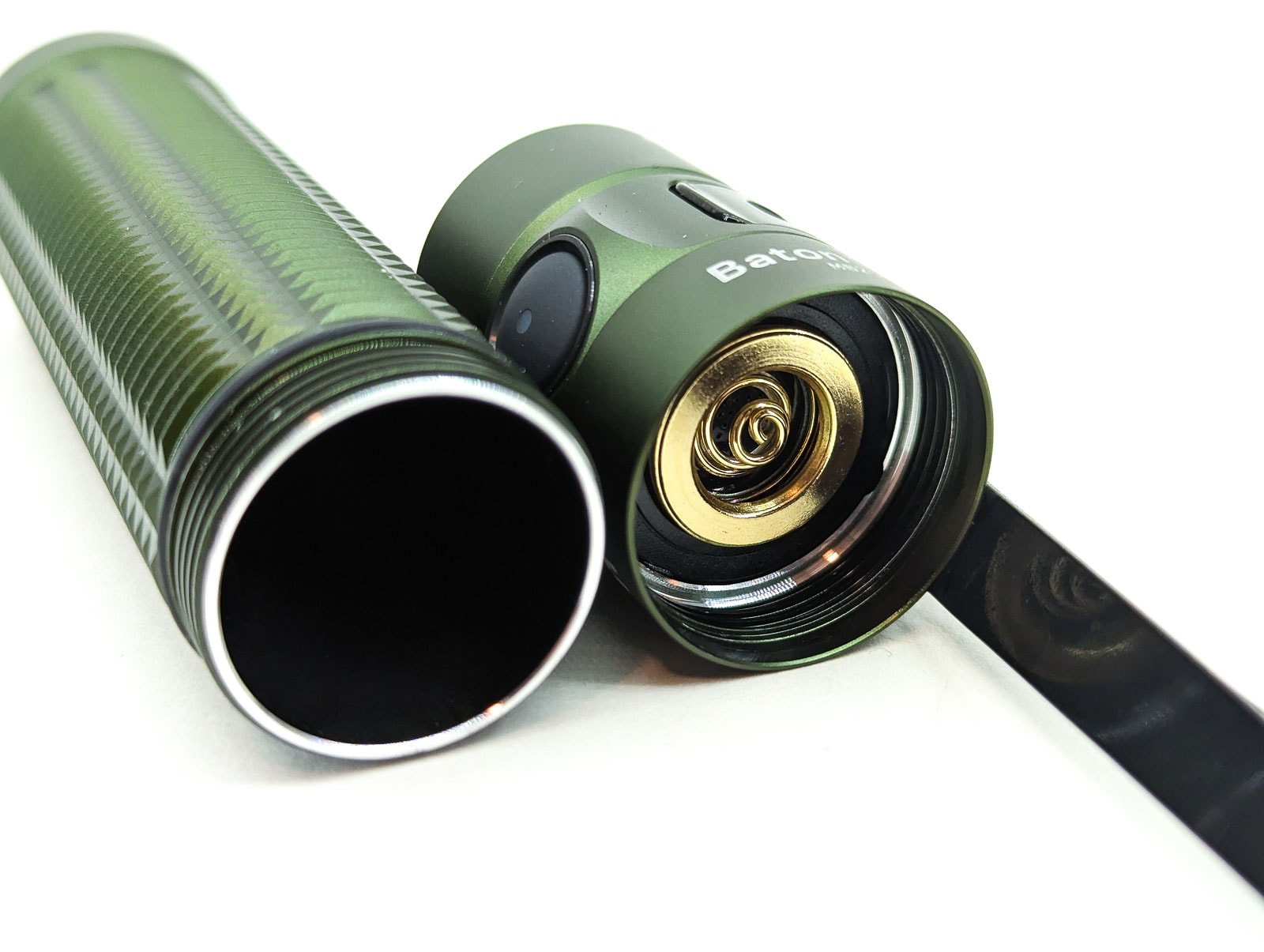
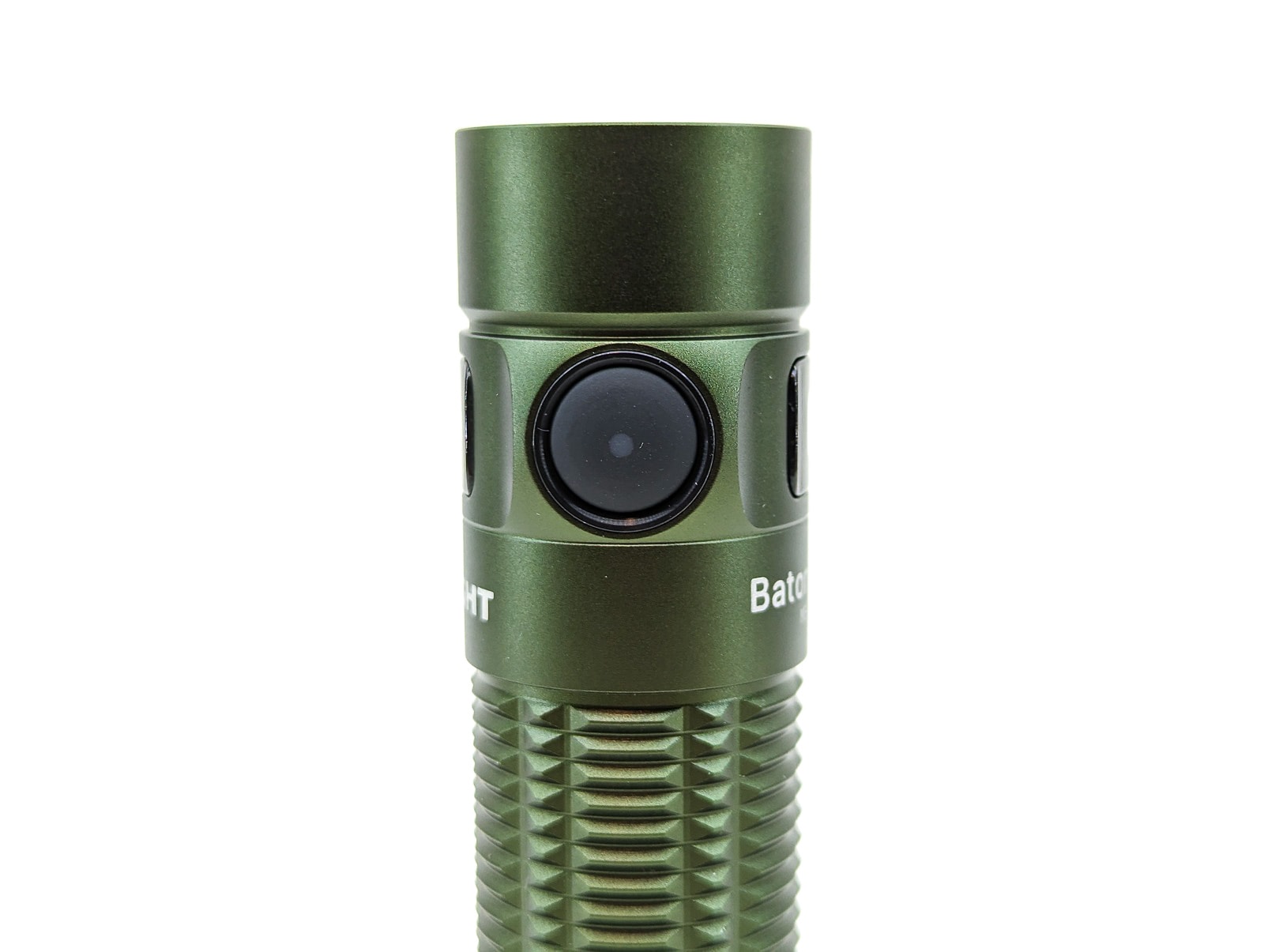
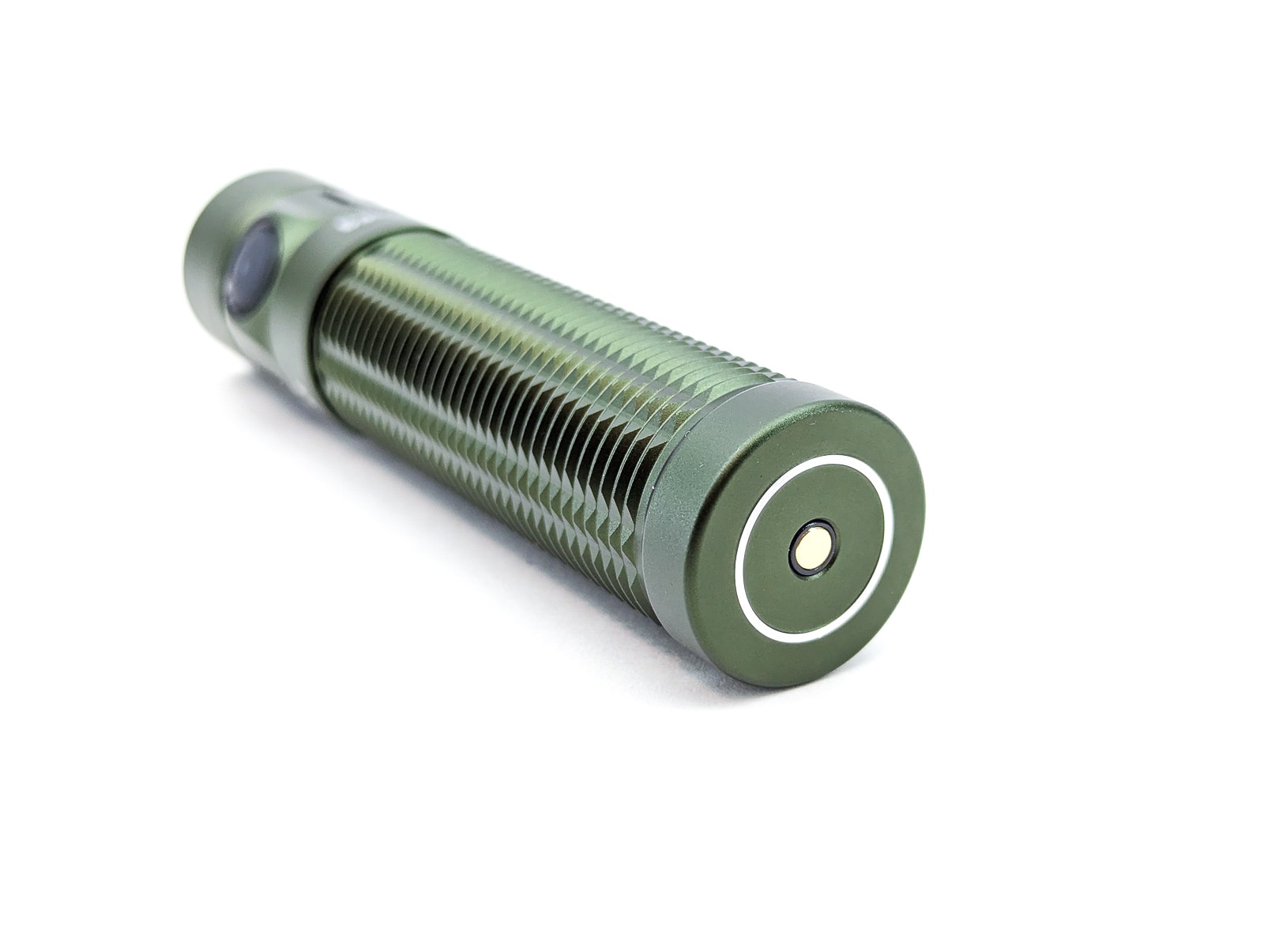
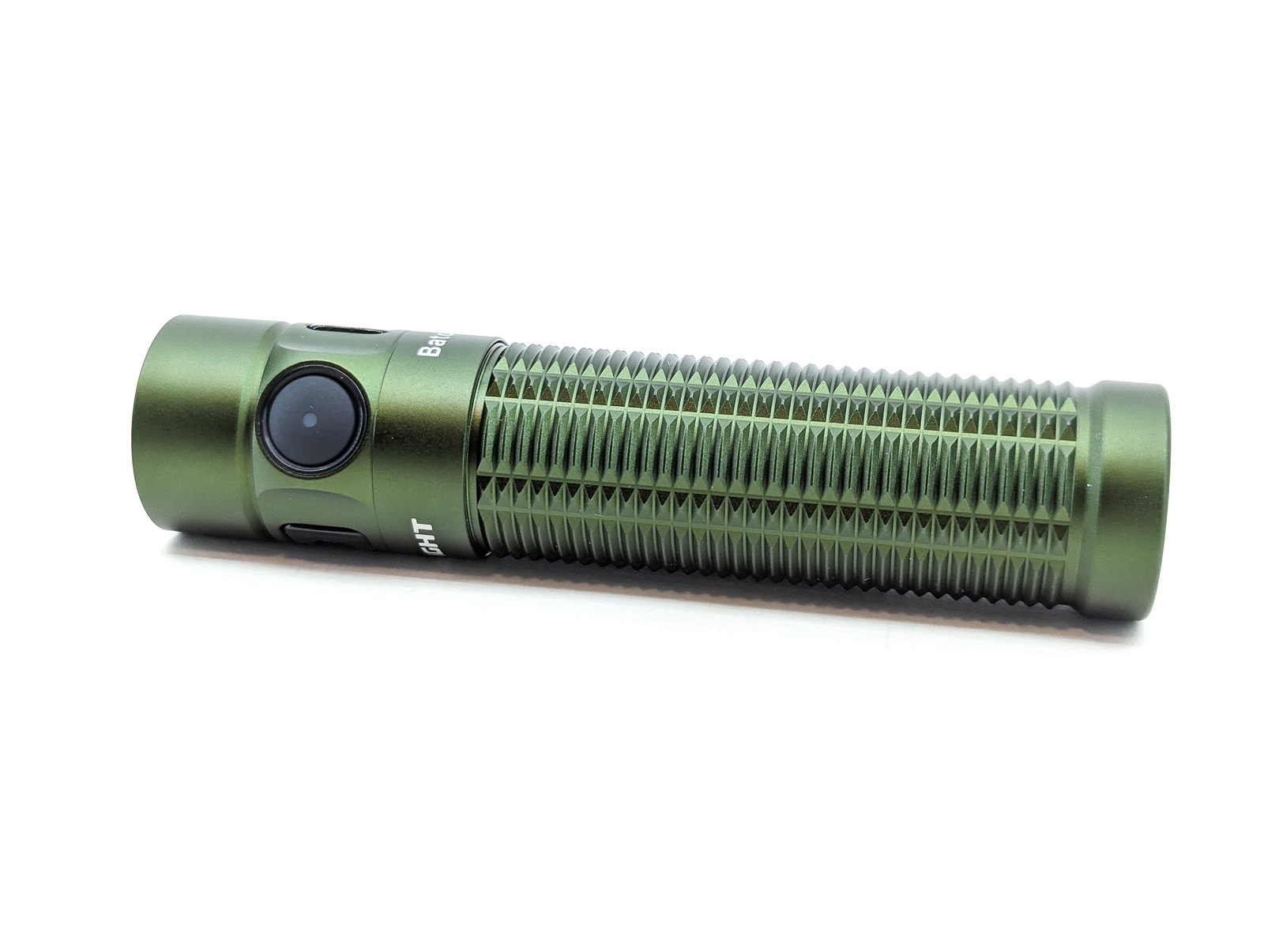
LED, Lens, Bezel, Beam, and Reflector
Historically speaking, Olight’s target audience has largely consisted of the Cool White fan club. But in recent times, a growing segment of the enthusiast population has pleaded for Olight to release Neutral (or perhaps Warm) White versions. It seems that Olight is now heeding that call, as several recent models have launched with both CW and NW – though both versions are still 70 CRI. The Baton 3 Pro Max is one of those, giving options for Cool White (5700-6700K) and Neutral White (4000-5200K) and now a Warm White (3000-4000K) option! Don’t get overly excited, though… all three options are still only 70 CRI. Olight sent a CW version for this review. While the bezel lists out all the CCTs (and the CRI rating), engraving on the side of the head confirms the CW rating. Note – at this time, only the black-anodized body is available in NW and WW. The OD Green (aluminum) and Desert Tan (magnesium alloy) appear to be CW-only, at least for now.
The bezel is more of a retaining ring for the TIR optic, as it sits flush with the top of the head. It appears to be made of plastic or aluminum, I can’t really tell which. The TIR optic appears to be a little unique, and this is likely due to the proximity sensor, providing a path for it to detect light that is being reflected back. As mentioned earlier – this is a different design than in the past. There is no longer a dedicated little cutout on the edge of the optic for the sensor. The optic has a faceted look to it, which likely helps with blending the beam. The TIR does a good job of creating a nice, even hotspot with just a little bit of spill. There doesn’t seem to be much of a tint shift at all.
While Olight hasn’t mentioned what LED is in play here, I can see that it’s a medium-sized quad-die. And since it’s available in a wide CCT range, that narrows options down. If this Reddit post is to be believed (and I see no reason not to), Olight Customer Service has confirmed that they’re using Cree XHP50.3 LEDs in the Baton 3 Pro Max. Based on appearances, I’d say that seems true.
Opple Light Master readings on Turbo at 3 meters:
- CCT: 6945K
- CRI: 74.5 Ra
- DUV: -0.0015


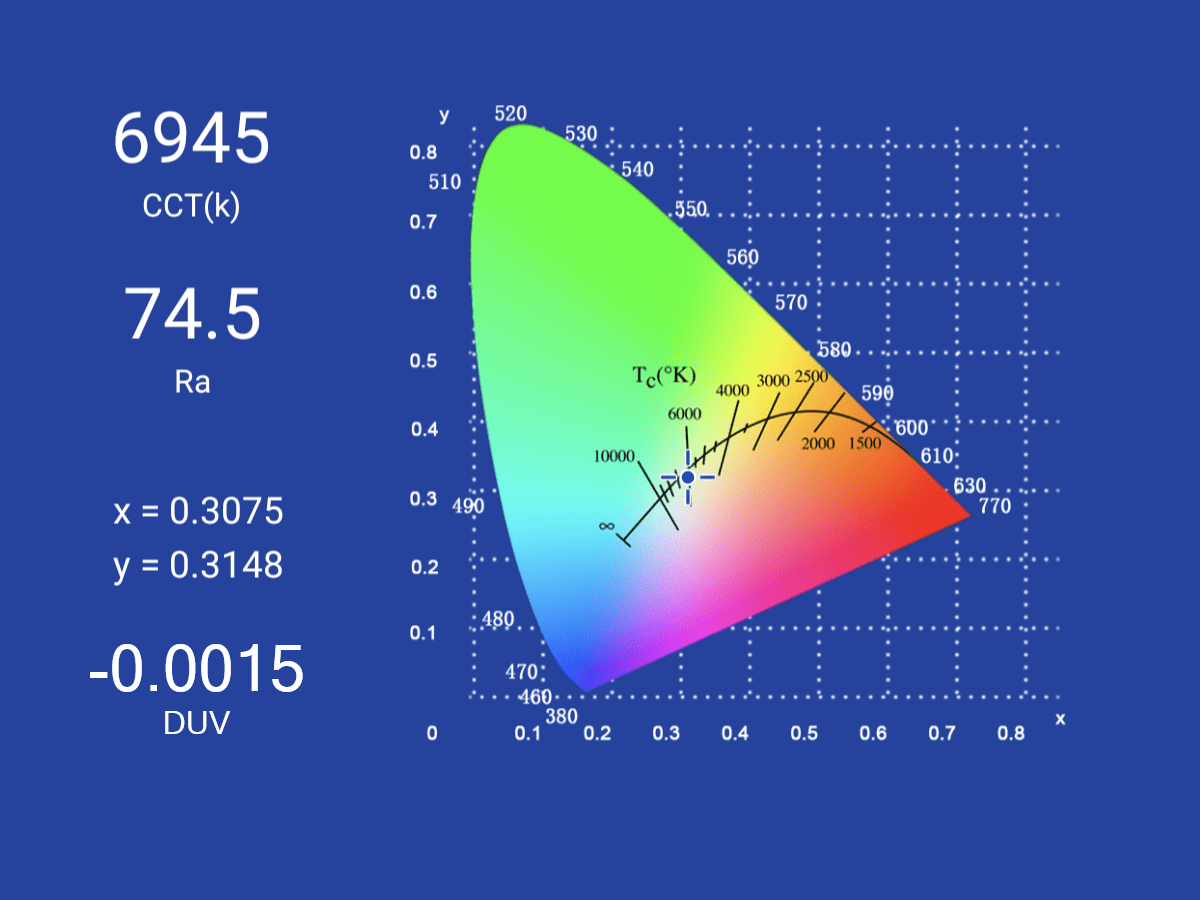
Dimensions and size comparison
Dimensions:
| Baton 3 Pro Max | Millimeters | Inches |
|---|---|---|
| Length | 114 mm | 4.5 in |
| Head diameter | 26 mm | 1.0 in |
| Body diameter | 26 mm | 1.0 in |
Dimensions are rounded to the nearest millimeter, and to the nearest tenth of an Inch.
Weight:
| Baton 3 Pro Max | Weight in grams | Weight in oz |
|---|---|---|
| Without battery: | 77 g | 2.7 oz |
| With battery | 148 g | 5.2 oz |
Weight is rounded to the nearest gram, and to the nearest tenth of an Oz.
Flashlight size comparison with its competition:
Group 1: Olight Arkfeld, Olight Baton 3 Pro Max, Olight Warrior Mini 2 Cu
Group 2: Nitecore P20iX, Olight Baton 3 Pro Max, Fenix PD36R Pro
Group 3: Astrolux ST01, Olight Baton 3 Pro Max, Sofirn SP35
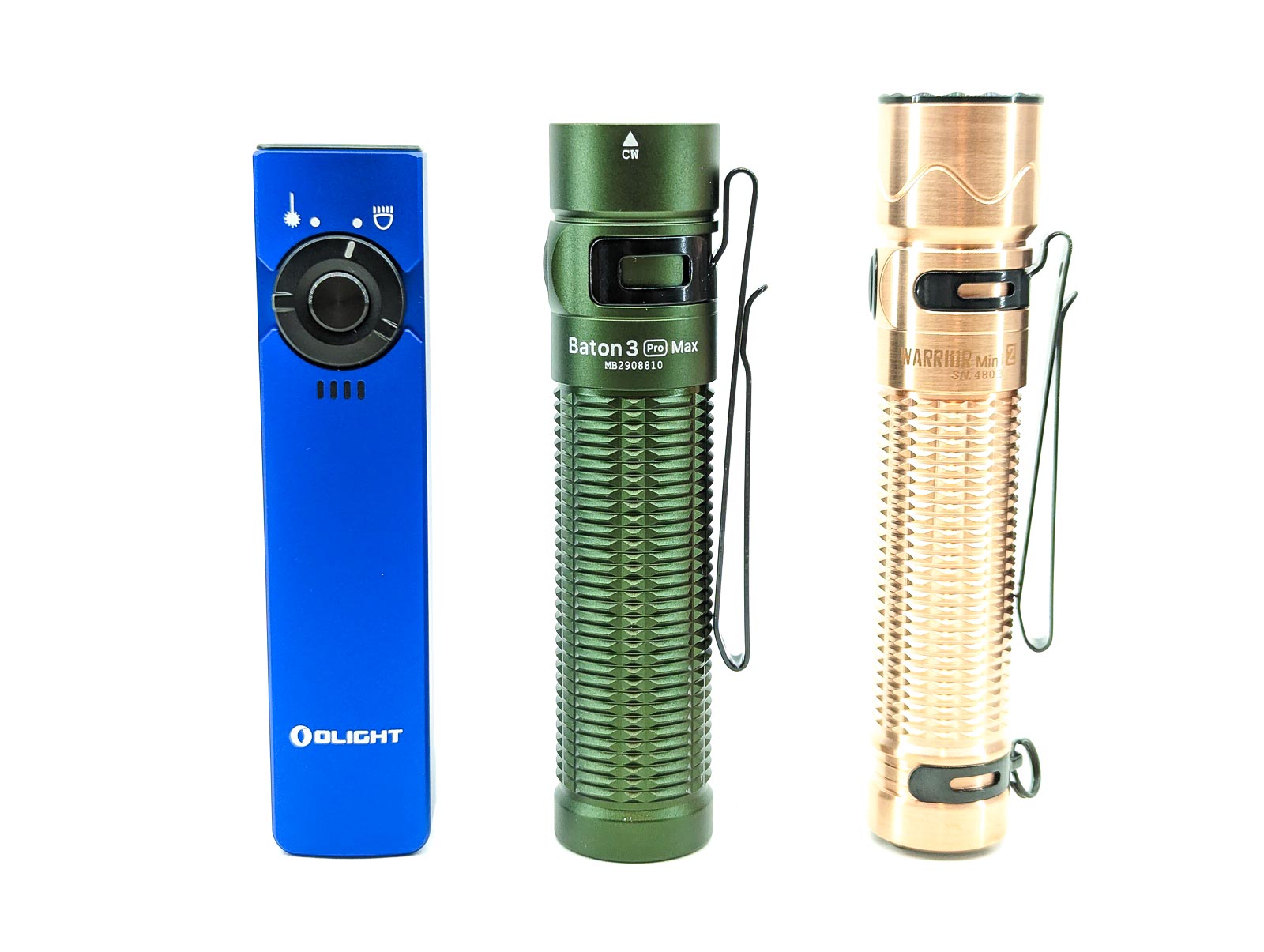
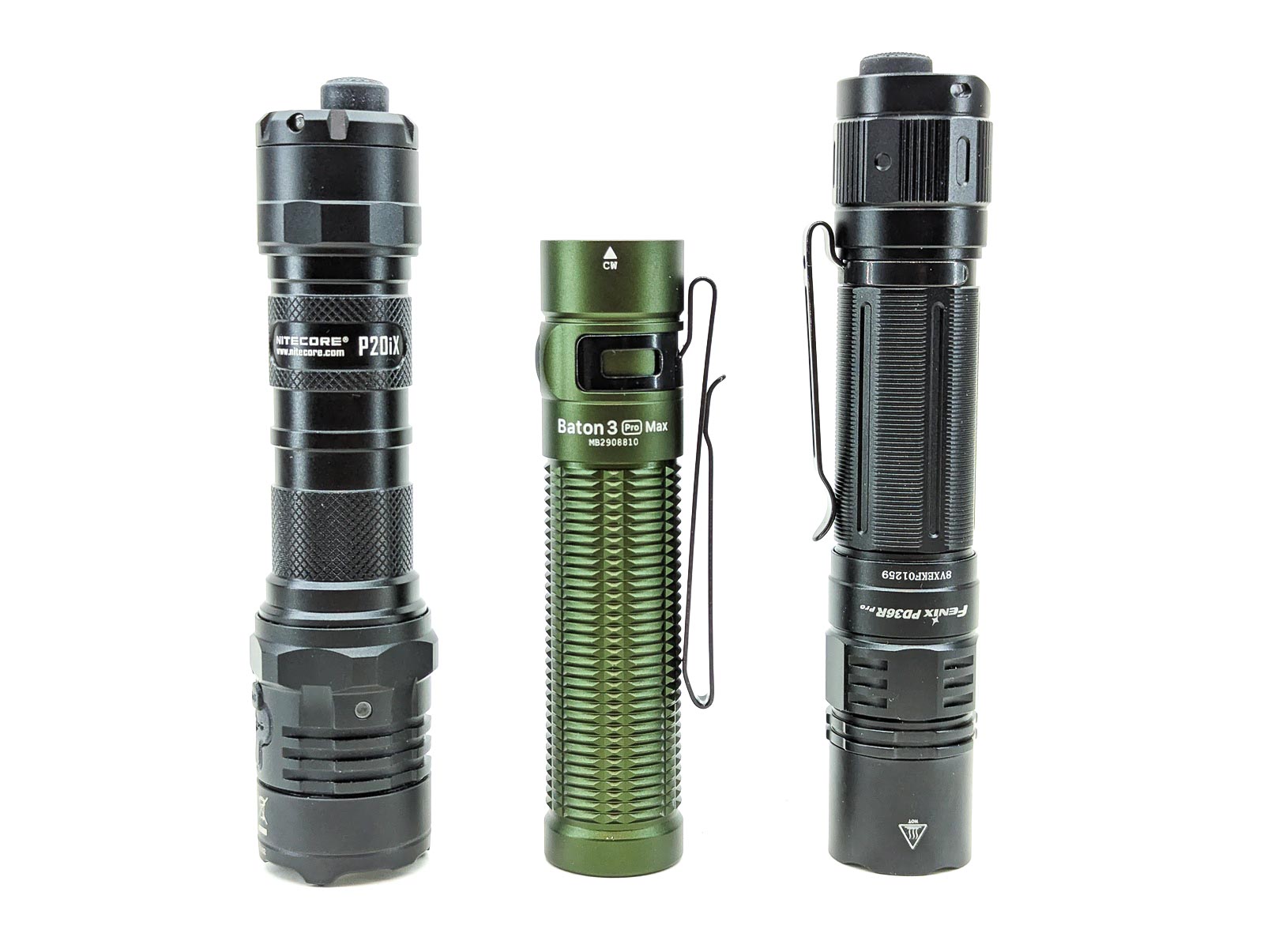
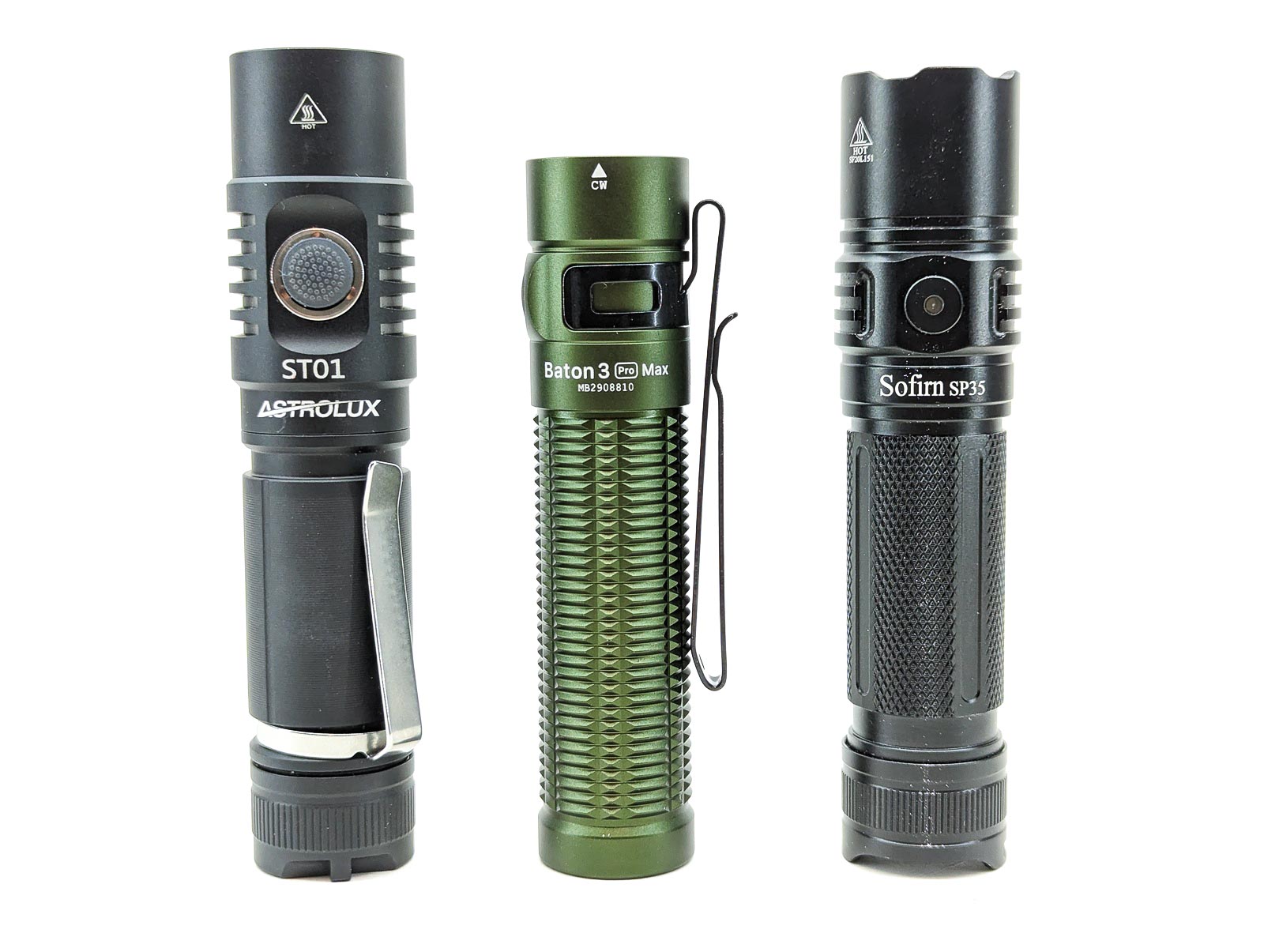
Driver & User Interface:
Available modes:
- Moonlight, Low, Medium, High, Turbo
Available blinky modes:
- Strobe
From OFF:
- Press and Hold 1-2 sec: Moonlight
- Press and Hold >2 sec: Lockout
- Single click: turn On
- Double click: Turbo
- 3 clicks: Strobe
From ON:
- Press and Hold: change modes (Low > Medium > High)
- 1 click: turn Off
- Double click: Turbo
- Double Press and Hold: activate timer
- 3 clicks: Strobe
Mode memory:
- If you turn the light back on within 1 minute of turning it off in Turbo or High, it will come back on in the High
- After 1 minute of being off, Turbo and High modes revert down to Medium mode
- Moonlight, Low, and Medium modes will be completely memorized
- Strobe mode cannot be memorized
Shortcuts:
- To Low: press and hold 1 second from Off
- To Turbo: double click (from Off or On)
- To Strobe: triple click (from Off or On)
Low voltage warning:
- There is an LED in the button that displays the battery level:
- Green: >60%
- Orange: 10-60%
- Red: 5-10%
- Blinking Red: <5%
- There’s no need to turn the light on to activate the battery level indicator – just give the light a little shake to wake it up and show the battery status. This is a pretty neat new feature, but I can’t help but wonder if there is any impact to standby draw.
Strobe/blinkies
- There is a strobe mode that can be activated with a triple click from Off or On
Lock-out mode:
- Electronic lockout mode is enabled by holding the button down for 2+ seconds while the light is off
PWM
- There is no PWM present
Additional info on the UI:
- There is also a neat Timer mode, as seen on other Olight models.
- With the light on and in your desired mode, do a double click + hold (press & release, press & hold) until you see a blink.
- One blink means that you activated a 3 minute timer.
- Two blinks means that you activated a 9 minute timer.
- To switch between the 3 minute and 9 minute timers, after you’ve activated the timer, do another double click + hold.
- Your timer preference (3 minutes versus 9 minutes) will be memorized for next time.
Batteries & Charging
Aside from the pickiness about LED preferences, I also see a lot of talk regarding Olight’s use of proprietary battery formats and the associated high cost of replacement batteries. I get it, but I personally think it’s overplayed. Lithium-ion batteries can last for hundreds of charge cycles. So even if you wear out this battery every couple of days, it should still last you a couple of years. At which point, if you use the light that much and you need to fork over $20 in maintenance for a tool that you use all the time? That seems like a no-brainer to me. And if you don’t use it that often, then you’re not going to wear the battery out and then what does it matter?
With that off my chest… yes, the Olight Baton 3 Pro Max does use Olight’s proprietary format with the negative contact around the positive pole. This helps enable the magnetic charging that Olight uses, while doing away with the need to do any finicky dual-tube stuff. The battery is a 5000 mAh 21700, labeled ORB-217C50.
The included MCC3 charging cable attaches firmly and easily to the tail of the light via magnetic attraction. When charging, the indicator on the MCC3 lights up red. When the charge cycle is nearing completion, the indicator turns green. In my tests, I observed a 1.85 amp / 9.43 watt charge rate. That’s a good speed for a 21700 battery, but the trickle charge went for a while after the indicator turned green. The indicator turned green a little after 3 hours and the charge rate was down to around 0.36 watts to top the battery up. Olight says the charge rate is 2 amps and the cycle should take 4 hours.
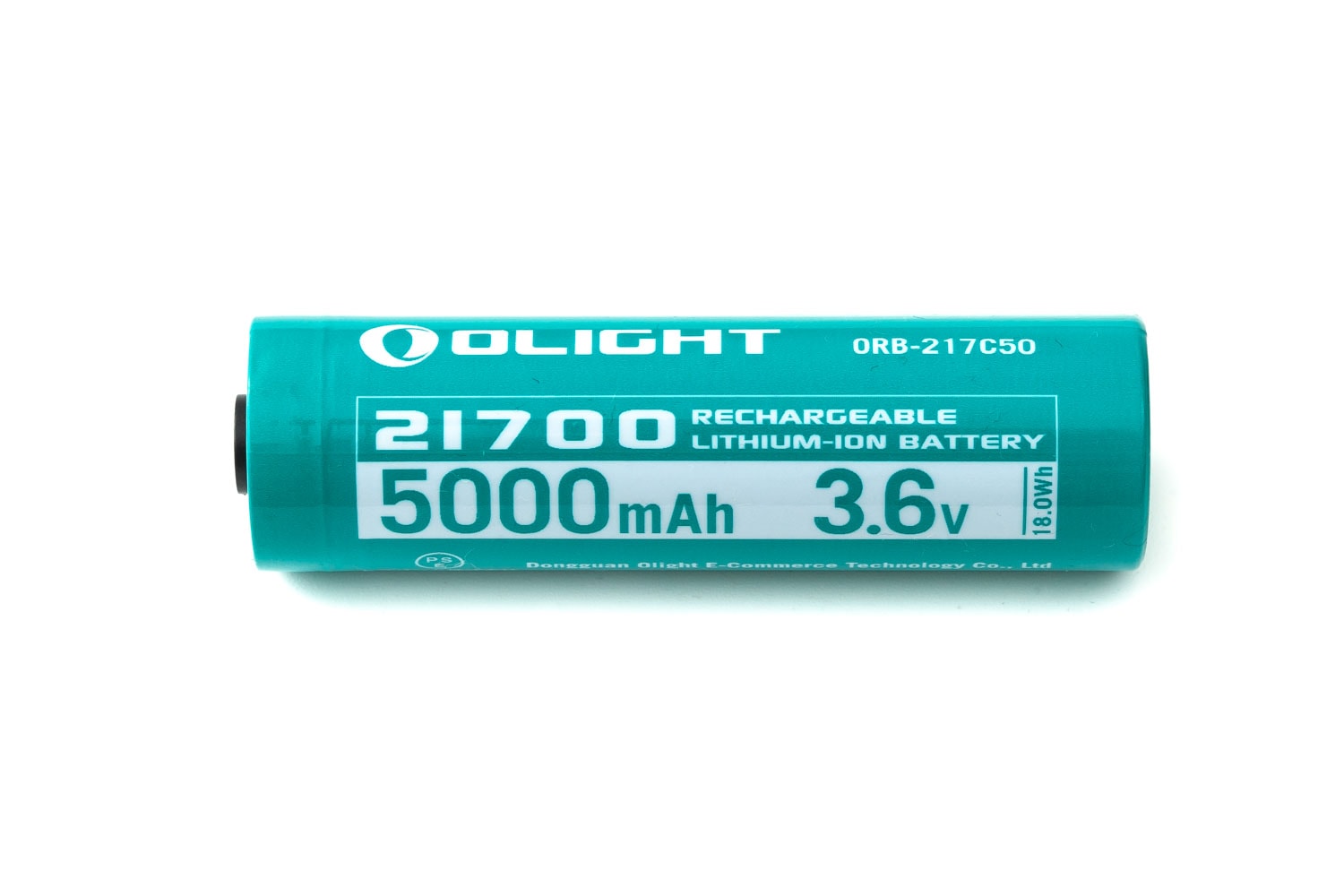
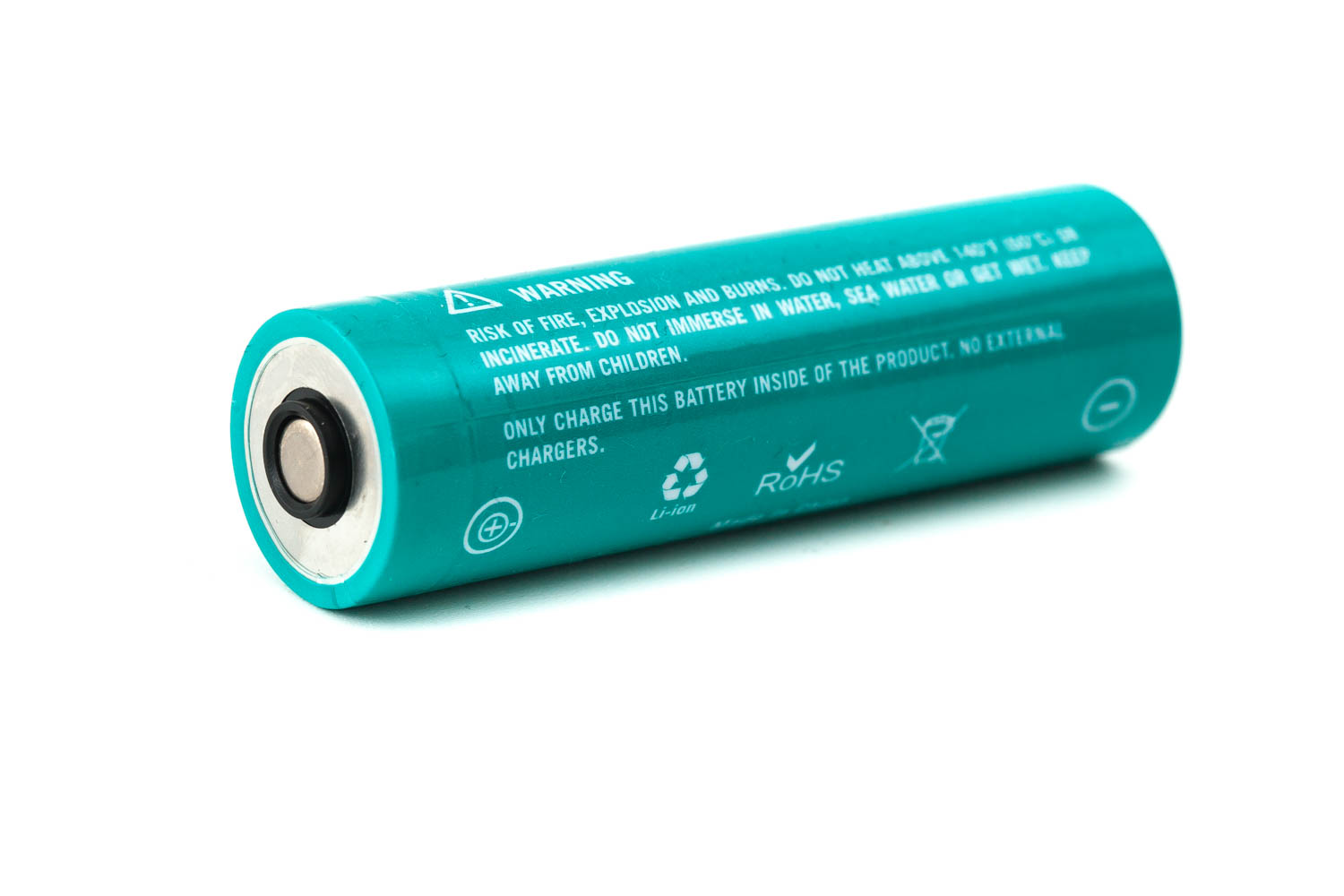

Performance test
Lux was measured by a UNI-T UT383 BT at 5 meters. Lumens were measured in a homemade lumen tube using a VEML7700 sensor, calibrated with a Maukka calibration light. Due to the nature of the flashlight design, current tests were not possible.
Lumen measurements (for each mode)
| Mode | Specifed | turn on | 30 sec | 10 minutes |
|---|---|---|---|---|
| Moon | 1 | 0.7 lm | 0.7 lm | – |
| Low | 15 | 12 lm | 12 lm | – |
| Med | 120 | 97 lm | 97 lm | 96 lm |
| High | 800 | 811 lm | 802 lm | 768 lm |
| Turbo | 2500 lm | 2,503 lm | 2,380 lm | 763 lm |
| Turbo at 3.6V | – | 1,291 lm | 1,274 lm | – |
Parasitic drain:
- N/A (can’t test due to flashlight design)
Overall, output was very in-line with the Olight specs, no real surprises. Do note that these specs are for the CW and NW models. The WW specs are slightly lower (eg, 2000 lumen max output).
Battery Life: Runtime graphs
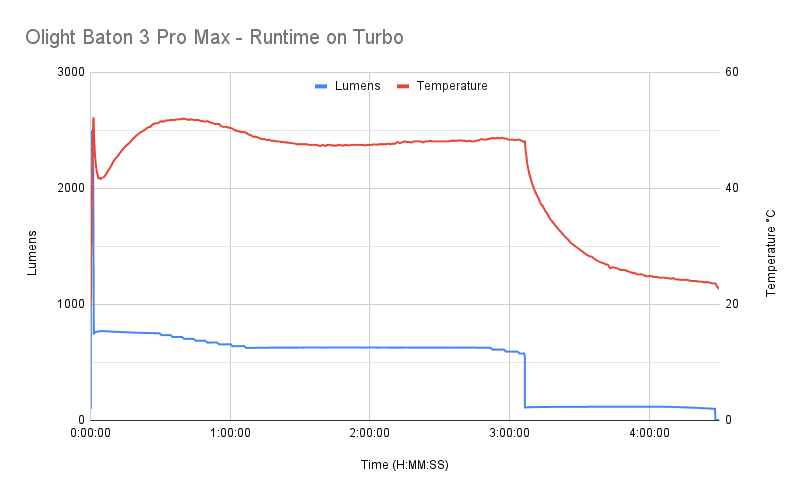
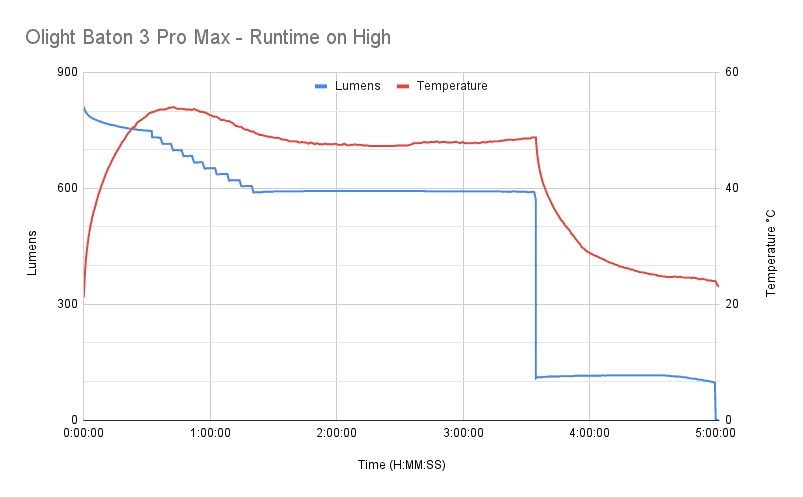
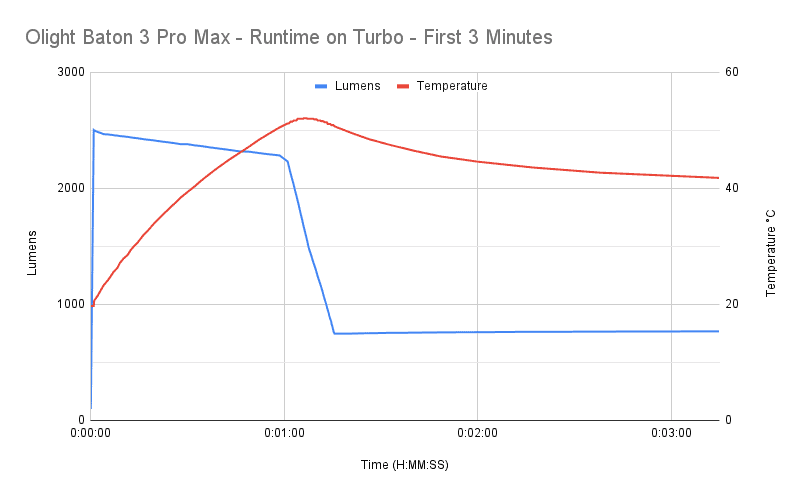
| Mode | Specified | Measured runtime ANSI | Time till shut off |
|---|---|---|---|
| Moon | 60 days | – | – |
| Low | 180h | – | – |
| Med | 23h | – | – |
| High | 5h 23min | 5h 0min | 5h 0min |
| Turbo | 4h 1min | 3hr 6min | 4h 28min |
ANSI FL1 standards: The runtime is measured until the light drops to 10% of its initial output (30 seconds after turning on). This does not mean that the flashlight is not usable anymore. The last column shows how long the light actually works till it shuts off. If there is a + symbol, it means that the test was stopped at that particular point, but the light was actually still running. This happens on certain occasions, with certain drivers, firmware, or batteries.
Peak beam intensity and beam distance measurements
Throw was measured at 5 meters after 30 seconds from turn-on.
| Mode | Specified | Candela measured | Meters | Yards |
|---|---|---|---|---|
| Low | 29 cd | – | – | – |
| Medium | 257 cd | 300 | 35 | 38 |
| High | 1730 cd | 1975 | 89 | 97 |
| Turbo | 5295 cd | 6125 cd | 157 | 171 |
Extra info: Peak beam distance according to ANSI FL1 standards: The calculated value of distance in meters at which the flashlight produces a light intensity of 0.25 lux. (0.25 lux is about the brightness of a full moon shining on an object). The columns ‘Meters’ and ‘Yards’ use rounded numbers.
Beamshots
Beam shots of the building are taken at 30 m (33 yd) using a Pixel 7 set to ISO 800 with 1/10 second exposure time
Beamshots of the following flashlights compared:
- Olight Baton 3 Pro Max
- Sofirn SP35
- Nitecore P20iX
- Fenix PD36R Pro
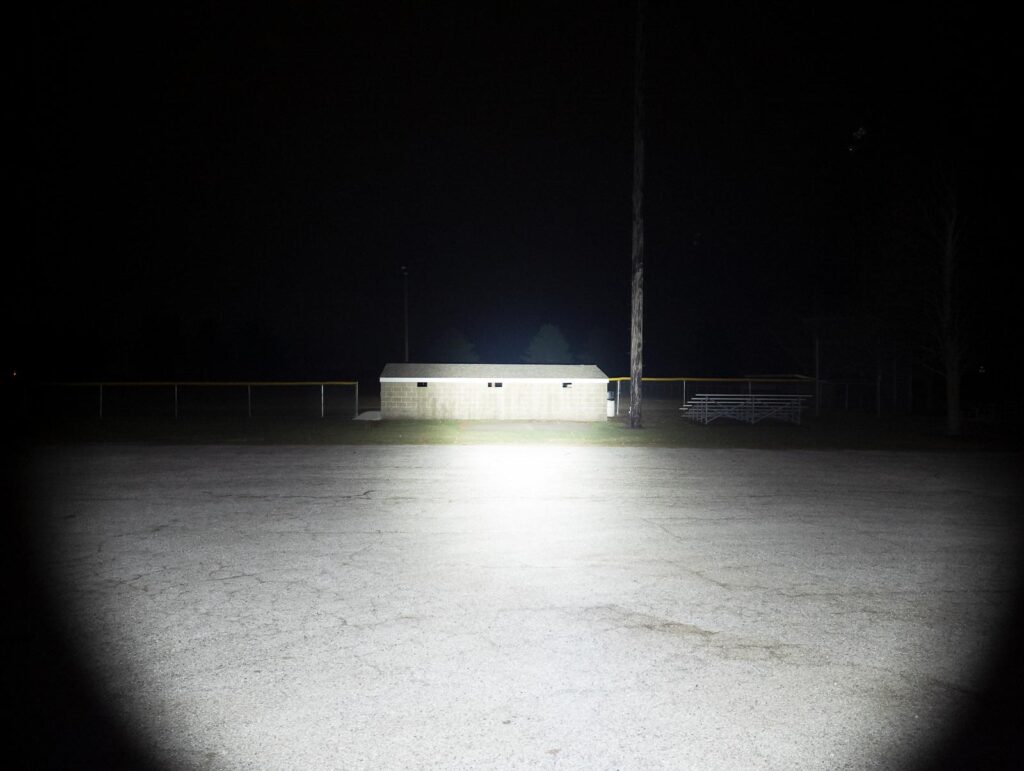
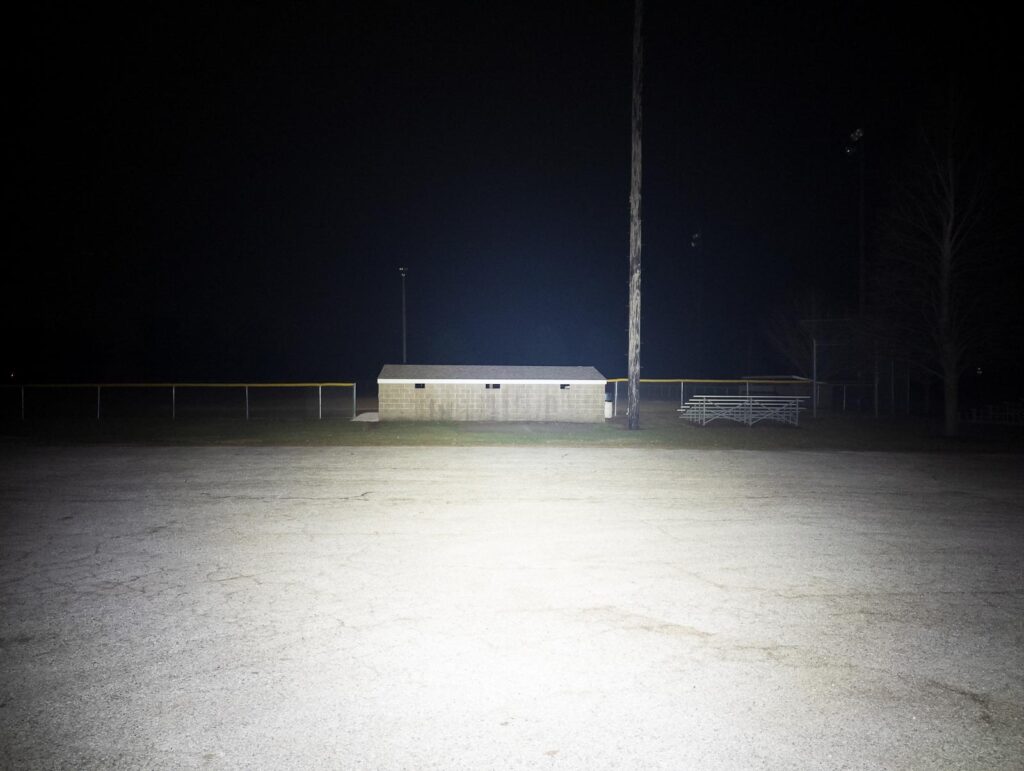
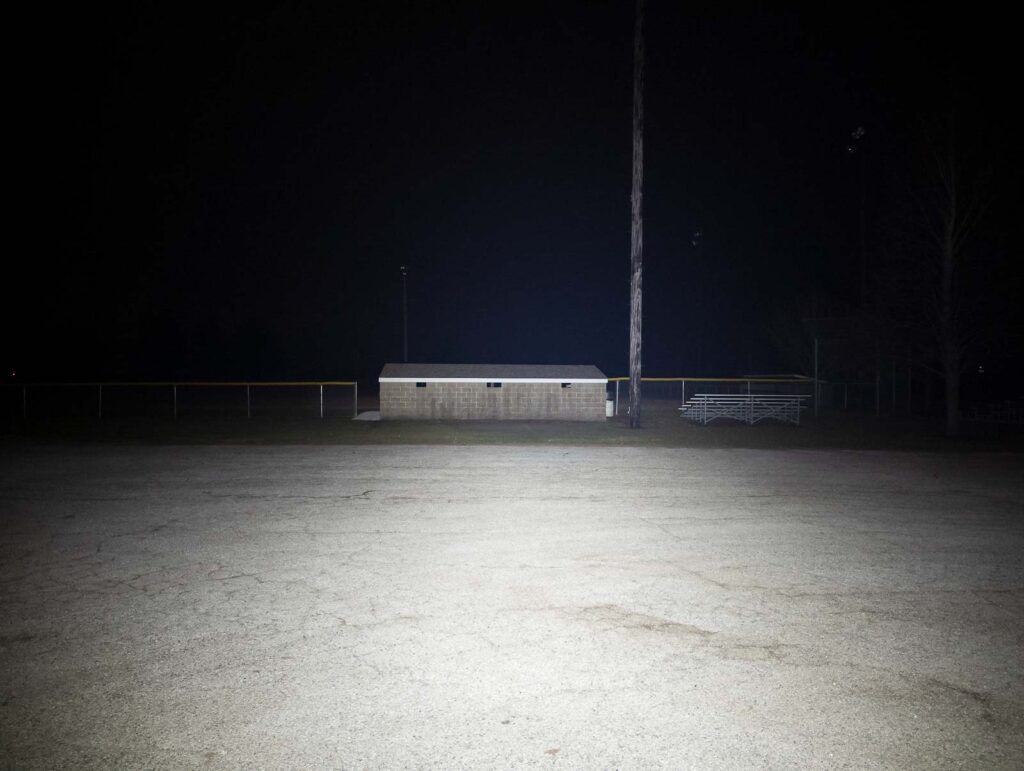
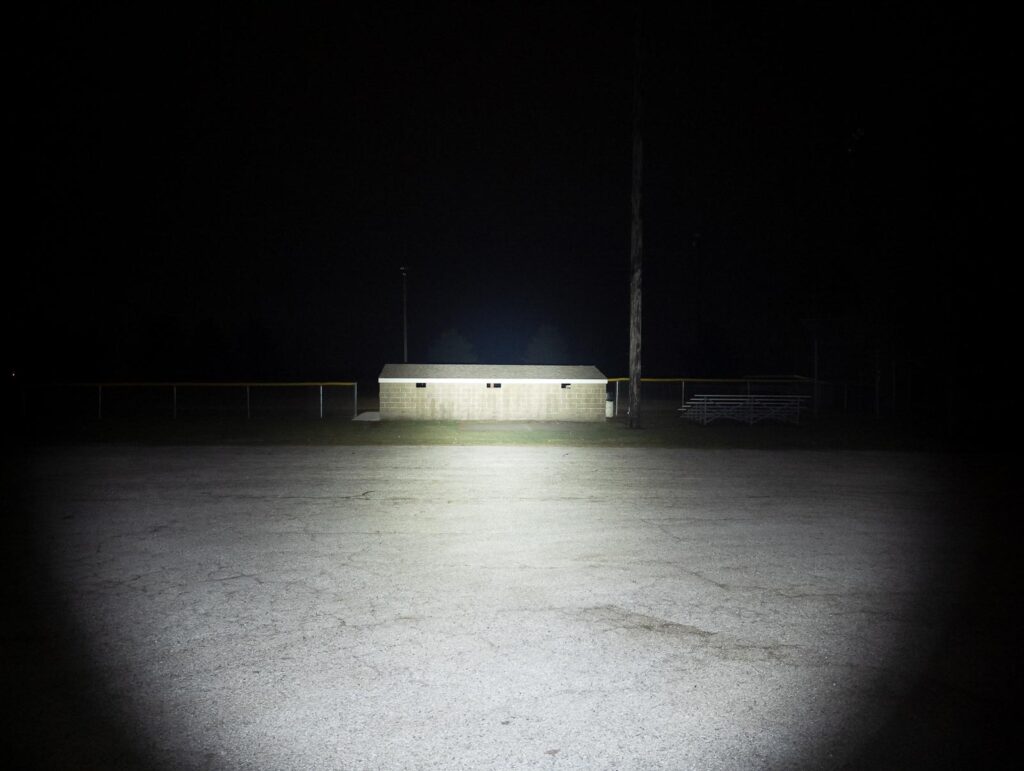
Disclaimer: This flashlight was sent to me for review at no cost by Olight. I have not been paid to review, nor have I been holding back on problems or defects.
Final Verdict
Pros
- Nice EDC size (maybe a little thick, but not bad)
- Excellent fit & finish
- Plenty of power
- Nice regulation
- Magnetic charging
- (nearly) Moonlight mode
- Good UI
Cons
- Turbo only lasts 1 minute
- Proprietary battery
- Low-CRI LEDs
Explanation on star ratings:
1: Avoid: a match would be a better choice – 2: Poor: significant defect or issues; almost unusable – 3: Average: some defects or issues; but still usable 4: Good: recommended (minor issues) – 5: Great: highly recommended

4.5 stars: ★★★★⋆
Olight really knows how to make a great flashlight. The build quality is excellent, has an impressive 5 year warranty, and it comes in a variety of attractive colors. Oh, and the Desert Tan model is made of magnesium alloy – it will be interesting to see how that plays out. Olight now also provides LED choices; you get your pick of CW, NW, and also WW (albeit, all options are 70 CRI).
The driver is great, both in terms of consistent regulated output, and a familiar easy-to-use UI. Moving up to the Max (21700-based) model from the Baton 3 Pro (18650-based), the extra boost in power and additional runtime are great. Aside from the low CRI rating, the Baton 3 Pro Max is about as nice of an EDC / around-the-house / camp light as you’ll find.
Olight Baton 3 Pro Max discount coupon
Use our exclusive 1lumen discount code to get an extra 10% off anything you order at Olightstore.com (USA). Coupon code: 1lumen
1lumen selects and reviews products personally. We may earn affiliate commissions through our links, which help support our testing.